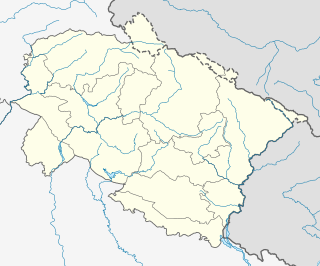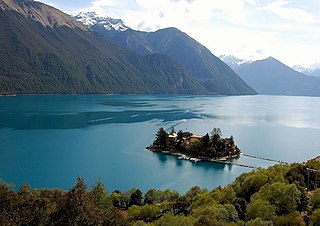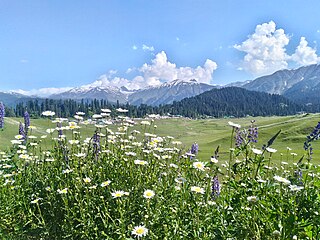
Valley of Flowers National Park is an Indian national park, located in Chamoli in the state of Uttarakhand and is known for its meadows of endemic alpine flowers and the variety of flora. This richly diverse area is also home to rare and endangered animals, including the Asiatic black bear, snow leopard, musk deer, brown bear, red fox and blue sheep. Birds found in the park include Himalayan monal pheasant and other high altitude birds.
Sattal or Sat Tal is an interconnected group of seven freshwater lakes situated in the Lower Himalayan Range near Bhimtal, a town of the Nainital district in Uttarakhand, India. During the British Raj, the area had a tea plantation, one of four in the Kumaon area at that time.

Singalila National Park is a national park of India located on the Singalila Ridge at an altitude of more than 7000 feet above sea level, in the Darjeeling district of West Bengal. It is well known for the trekking route to Sandakphu that runs through it.

Almora is a municipal board and a cantonment town in the state of Uttarakhand, India. It is the administrative headquarters of Almora district. Almora is located on a ridge at the southern edge of the Kumaon Hills of the Himalaya range, at a distance of 363 km from the national capital New Delhi and 415 km via Saharanpur Rd, 351 km via NH109 and 388.6 km via Ambala- Dehradun- Haridwar Rd from the state capital Dehradun. According to the provisional results of the 2011 national census of India, Almora has a population of 35,513. Nestled within higher peaks of the Himalaya, Almora enjoys a year-round mild temperate climate. The town is visited by thousands of tourists annually from all over the world. There are 11 blocks in Almora district.

Mashobra is a town in Shimla district of Himachal Pradesh. It is connected to the state capital Shimla through the historic Hindustan–Tibet Road built in 1850 by Lord Dalhousie.

The Eastern Himalayan broadleaf forests is a temperate broadleaf forest ecoregion found in the middle elevations of the eastern Himalayas, including parts of Nepal, India, and Bhutan. These forests have an outstanding richness of wildlife.
Chail Sanctuary is located at Chail, a hill station which is home to sambar, goral and cheer pheasants at Blossom and Jhaja. Barking deer and kalijin are seen during dusk and dawn. The best time to visit is from March to October.

The Northern Triangle temperate forests is a temperate broadleaf and mixed forest ecoregion of thick forest covering the mountains of northern Myanmar.

Kedarnath Wild Life Sanctuary, also called the Kedarnath Musk Deer Sanctuary, is a wildlife sanctuary declared under Wildlife Protection Act, 1972 and located in Uttarakhand, India. Its alternate name comes from its primary purpose of protecting the endangered Himalayan musk deer. Consisting of an area of 975 km2 (376 sq mi), it is the largest protected area in the western Himalayas.It is famous for alpine musk deer, Himalayan Thar, Himalayan Griffon, Himalayan Black bear, Snow Leopard and other flora park and fauna. It is internationally important for the diversity of its flora and fauna.

Hkakaborazi National Park is a national park in northern Myanmar with an area of 3,812.46 km2 (1,472.00 sq mi). It was established in 1998. It surrounds Hkakabo Razi, the highest mountain in the country. It ranges in elevation from 900 to 5,710 metres comprising evergreen forest and mixed deciduous forests in Nogmung Township, Kachin State. It is managed by the Nature and Wildlife Conservation Division. It is contiguous with Bumhpa Bum Wildlife Sanctuary and Hukaung Valley Wildlife Sanctuary. These protected areas together with Hponkanrazi Wildlife Sanctuary comprise the largest continuous expanse of natural forest called the Northern Forest Complex stretching over an area of 30,105 km2 (11,624 sq mi). Its objective is to conserve the biodiversity of the Ayeyarwady and Chindwin river basins.

The Western Himalayan broadleaf forests is a temperate broadleaf and mixed forest ecoregion which is found in the middle elevations of the western Himalayas, including parts of Nepal, India, and Pakistan.

The Eastern Himalayan subalpine conifer forests is a temperate coniferous forests ecoregion which is found in the middle and upper elevations of the eastern Middle Himalayas, in western Nepal, Bhutan, and northern Indian states including Arunachal Pradesh and Sikkim.

The Northeastern Himalayan subalpine conifer forests are a temperate coniferous forests ecoregion of the middle to upper elevations of the eastern Himalayas and southeast Tibetan Plateau. The ecoregion occurs in southeastern Tibet Autonomous Region, China, in northern and eastern Arunachal Pradesh, India, and extreme eastern Bhutan.

The Western Himalayan subalpine conifer forests is a temperate coniferous forests ecoregion of the middle and upper elevations of the western Middle Himalayas of Nepal, India, and Pakistan.

Govind Pashu Vihar National Park and Wildlife Sanctuary is a national park in Uttarakhand, India established initially as a wildlife sanctuary in 1955, and was later converted into a national park. It is named after a prominent Indian freedom fighter and politician Govind Ballabh Pant, who became Home Minister in 1955 and is remembered for his achievement in establishing Hindi as an official language.

Khadg Singh (KS) Valdiya was an Indian geologist and a former vice chancellor of Kumaon University, known for his contributions in the field of geodynamics. A 2007 recipient of Padma Shri, he was honoured again by the Government of India in 2015 with Padma Bhushan, the third highest Indian civilian award.

Naina Devi Himalayan Bird Conservation Reserve is a wildlife reserve in the Nainital district of the state of Uttarakhand in India. This reserve forest is located in Kumaon region of Uttarakhand and placed inside Nainital forest division. Nainital forest division at present has several birding trails and forest patches consisting of temperate broad-leaf forests to alpine grasslands to rhododendron shrubberies. Wide altitudinal variation supports a very large segment of avian fauna to inhibit in this forest range.

The Gulmarg Wildlife Sanctuary spread over 180 square kilometres (69 sq mi) is a protected area in Baramulla district of Jammu and Kashmir, India. The sanctuary lies on the north-eastern side of the Pir Panjal mountain range and falls under the northwest Biogeographic Zone 2A. It lies 50 kilometres (31 mi) south-west of Srinagar and 26 kilometres (16 mi) from Baramulla. The sanctuary was first declared as a game reserve in 1981 and later upgraded to a sanctuary in 1987.
The Gurez National Park, also known as Musk Deer National Park, is one of the protected areas of Pakistan. It is located in Neelum District in Azad kashmir, Pakistan, besides the Neelum River in the Gurez valley. It is located in the high Himalayas and Pir Panjal Range. It is a thirty-five minute drive from Gurez tehsil. It is also known as Gurez valley national park.

















